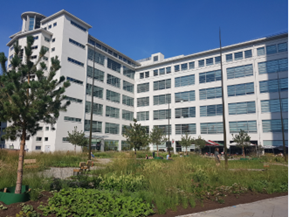
Area characterisation:
Rain- and stormwater draining from the square and from parts of the Witte Dame building is collected into 2 000 m2 and 15 cm high boxes on top of the parking. Capillary action makes the water available for the trees and plants on the square. Excess stormwater is later collected by the sewer, which by that time is empty again. This results in a decreased load for the sewers. Trees, shrubs, perennials and grasses have been planted to enhance evapotranspiration, which will aid in regulating the peak temperatures and flood peaks on the square. The pavement on the square was replaced with plant sections. The existing natural stone pebbles and lighting were partially reused, and a walking route was built across the square as well as a terrace space. To ensure the success of the capillary action, extra moisture-regulating clay granulate was mixed through the soil substrate.
Objective:
The previously stone-covered Clausplein square is located in a dense urban area in the city centre of Eindhoven and is greatly affected by extreme weather events. After reconstruction, the square has become a small urban park with an underground water retention basin.
Potential impacts/benefits:
The new urban green space in Clausplein decreased the physiological equivalent temperature (PET) at maximum by 20% relative to the reference measurements as well as decreased the temperature of the surrounding environment and buildings which was evaluated with thermal cameras outputs. NbS contributed to 16% increase in species diversity featuring 95% of native plant species after NbS implementation as compared to two control sites.
Transferability of result:
The design of the square has set a good example for future developments and projects. Although the area to some extent is unique, for example the presence of a parking garage below the square, parts of the system can be replicated.
Lessons learnt:
Private actors can be integrated into NbS financing, but it requires more careful planning and discussion among parties. Establishing joint initiatives (e.g., Communities of Practice or through other collaborative NbS effort) aid in overcoming reluctance to accepting NbS and establishing cohesion.
Organisations:
City of Eindhoven, https://www.eindhoven.nl/en
NBS goals:
- Enhancing sustainable urbanization
- Developing climate change adaptation
- Urban regeneration through nature-based solutions
- Nature-based solutions for improving well-being in urban areas
- Multi-functional nature-based watershed management and ecosystem restoration
- Increasing carbon sequestration through nature-based solutions
NBS benefits:
- Flood peak reduction
- Increasing infiltration
- Reduce risk of damages from drought
- Reduce run-off
- Reducing temperature at meso or micro scale
- Increase Biodiversity
- Increase quality and quantity of green and blue infrastructures
- Changing image of the urban environment
- Creation of green jobs relating to construction & maintenance of NBS
- Increase accessibility to green open spaces
- Increase amount of green open spaces for residents
- Increase awareness of NBS solution & their effectiveness and co benefits
- Increase social interaction
- Increase willingness to invest in NBS